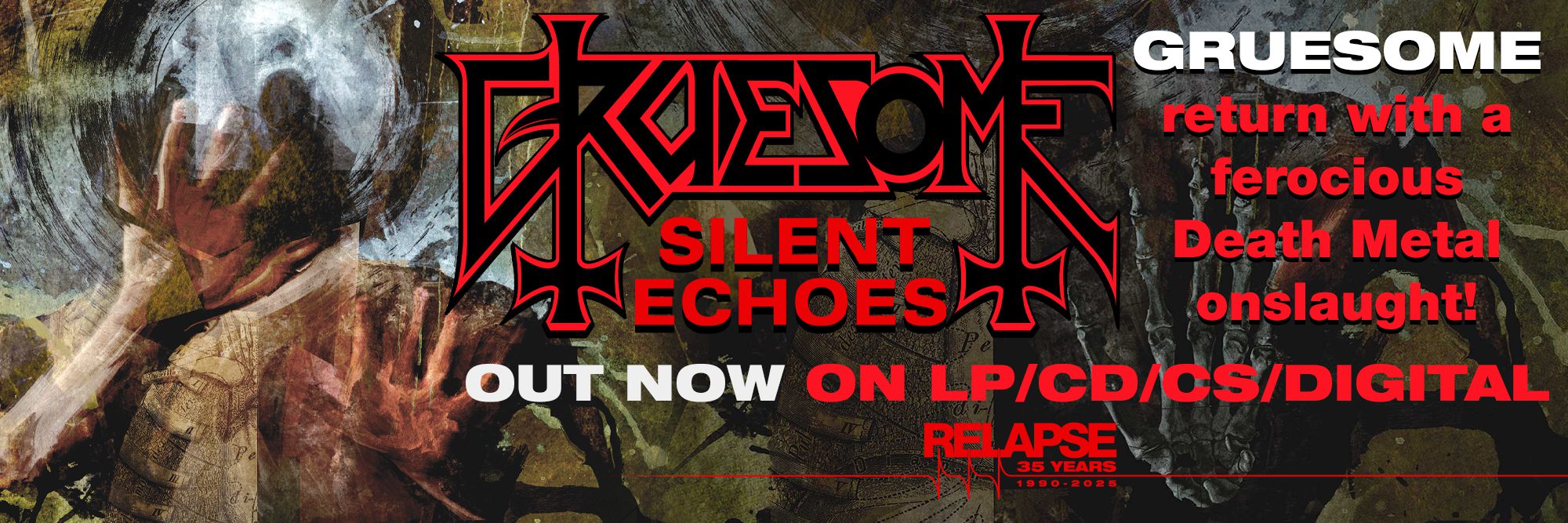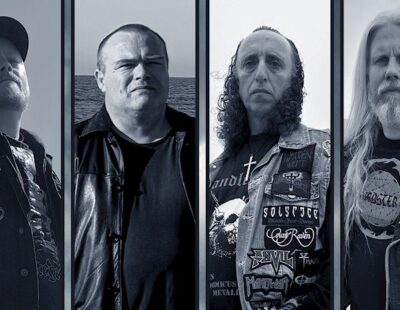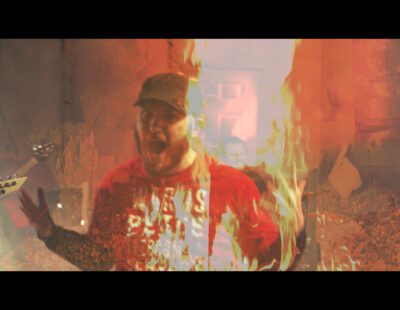
Synthwave maven Dan Terminus got his start on debut, Stratospheric Cannon Symphony, an album originally meant to score an as-yet-released video game. Response was so overwhelming to the eventually-released Stratospheric Cannon Symphony that Terminus realized he had something official to preoccupy his time and creative energy. Now, three years later, the French maestro of the digitally obtuse, futuristically existential has released his most accomplished effort to date in Automated Refrains. Envisioned, designed, and built by Terminus in his France-based music lab, Automated Refrains continues from — but is absolutely its own maniacal tendril — previous effort, The Wrath Of Code. Actually, Terminus states below, he didn’t want to write another The Wrath Of Code when composing Automated Refrains. To wit, Terminus’ new music is more direct, more aggressive, yet still whimsical and fanciful in its sonic predilection. Songs like “Fall of the Ancient World,” “Friendship Through Clear Plastic Walls,” “Electronic Snow,” and masterpiece “Grimoire Blanc” detail Terminus’ world of automatons without human oversight, artificial beings set in motion by the demise or absence of their creators. Musically, it’s like Tangerine Dream getting caught in a disco color wheel, where menace, doubt, fun, longing, and determination set the moods in- and between themes/pieces.
Decibel contacted Terminus via dial-up modem to talk Automated Refrains, the message behind it, the brilliant cover art, and how old-school technology — for Terminus — isn’t the bees knees. Prepare to be derezzed. Or, is it re-rezzed? We’ll let you figure that one out.
What were some of the primary motivators to start Dan Terminus?
Dan Terminus: I was making electronic music to pass time, to explore new possibilities and see where my creativity would take me. To put it simply, I enjoy making music and I hadn’t been making music for too long a time. I also wanted to make electronic music in a more contemporary way, because at the time I was using an Atari 520 STe, a 4-track tracker and samples on floppy disks. That’s fun, roots and vintage, but also quite restricting. I released some tracks, then a whole album, people liked it. That made me want to write more music, etc.
Synthwave isn’t a particularly French phenom, but the roots are strong in France. Why do you think that is? Is it something that’s spiraling out from, say, Daft Punk? Like Valerie Collective. And from there further spirals have been created?
Dan Terminus: I have absolutely no idea. The French have always had a thing for electronic music: Jean-Michel Jarre, Daft Punk, Air, Justice, Sebastian, etc. Maybe it’s the food. Maybe it’s the girls. Maybe it’s the language. Maybe all three together. I just don’t know.
What kind of gear do you use? A lot of folks just think it’s just a laptop.
Dan Terminus: And they’re right, because anyone these days can make an electronic music album with a laptop and a few VSTs. To produce my music, I use an old PC with no Internet connection, FL Studio, some VTSs, a MIDI keyboard, Fostex monitors and a keyboard/mouse. I also use Renoise sometimes. That’s pretty much all I need because I feel uncomfortable in a studio crammed with gear. In terms of hardware, I also have a Korg M1, a Korg WaveStation EX, and a Korg Minilogue. For live shows, I use an Akai APC40MkII to trigger samples and notes, a few virtual synthesizers, a laptop and the Korg Minilogue connected to an extra distortion pedal: either a Marshall Shredmaster or a DOD FX86 Death Metal. I use the Minilogue as a MIDI controller sometimes, to play the virtual synths live. Not blowing smoke up Korg’s ass, but the Minilogue is one mean machine. I’d like to bring more gear on tour although I know the risks. Even with the sturdiest of flightcase, you never know in which state you’ll find your gear after it’s been hauled and slammed in an aircraft container, especially for ‘vintage’ synths.
Do you do your own mixing and mastering? Automated Refrains sounds killer.
Dan Terminus: Thank you. Yes, I mix and master everything myself. I have a pretty straightforward approach to mastering, though. There are sound techs out there who will be pissed at what I’m going to say but I believe mastering is a waste of time for the kind of music I make, to the point it’s almost useless. I wouldn’t say that for a jazz band, a classical music recording or a death metal band, though. Automated Refrains is more in your face, more aggressive, more complex also. The overall sound might feel unpleasant at times, which is something you can’t go wrong with.
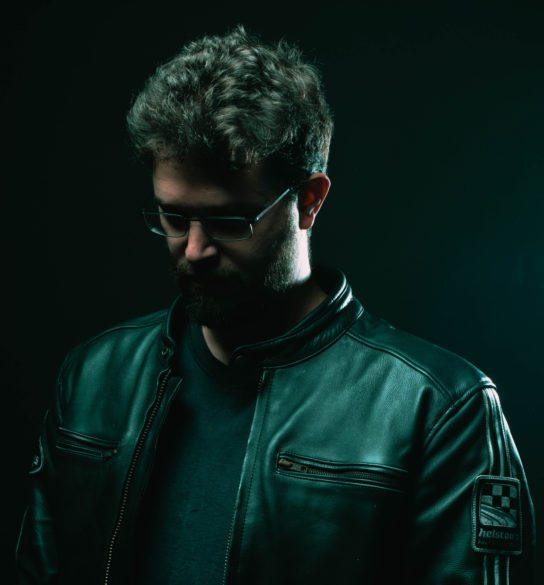
You’re now on your fourth full-length, Automated Refrains. What’s different now compared to 2014 with Stratospheric Cannon Symphony?
Dan Terminus: Stratospheric Cannon Symphony is a sci-fi album, containing a lot of tracks that should have ended up as the OST of an indie videogame, but for some reason it never happened and the game was never released, not even finished. At the time, I thought it would be fun to release these tracks, instead of keeping them to myself. There’s a difference in the way that Stratosheric Cannon Symphony is a collection of almost ambient tracks. It has a lighter tone, a softer approach to putting things through. Even “Digital Onslaught” and “Universal Declaration of Cyborg Rights” are tracks that sound super mellow and super soft to my ears, today. 2014 was a fun year because I was learning new production techniques every day. It helped me create in my DAW the sounds I’d hear in my head. It’s also the most positive album I’ve released, as of today (not counting the Rêverie EP, which is cheesy and mellow on purpose). I like what Dallas Campbell and Tommy ’86 came up with, it brightens the album.
Are you surprised you’ve come this far in such a short period of time? You’ve hit #1 on the Bandcamp charts recently. Congrats!
Dan Terminus: Thank you. I don’t really care about that. The only thing that matters is the music: if people play my music and enjoy what they hear, then the rest doesn’t matter.
What do you think separates you from other synthwave artists?
Dan Terminus: The fact that I’m drifting away from synthwave. Except for a few talented producers, synthwave has become really boring, shallow, monotonous and bland. I’m not saying I’m better than anybody else, though. I’m saying that I try to come up with something that’s not your regular side-chained bass over the same old Linndrum kick and gated snare. As I said, I enjoy making music. I’m not here to replicate a formula over and over again. I could have written The Wrath of Code 2, but then what? It’s not satisfying. Oh, and also, I have an ‘official’ painter, Luca Carey, who designs my album covers and art. And I believe that’s quite striking. Check him out here: www.rainbots.com. I believe that someone who looks at the paintings he did for my music would instantly recognize me, so that’s something I’m proud of.
Is Dan Terminus strictly a product of ’80s sonic qualities, movies, soundtracks, TV shows, video games, etc.?
Dan Terminus: Not really. I like everything you mentioned, but I’m not stuck in the ’80s. Of course, I love cheesy ’80s synthesizer sounds (and I know some people out there are telling me to cut that Pan Flute thing out), but I’m not that specific. It’s just me, hearing something in my head, arranging it and then patiently reproducing it in my DAW. So I guess I’m influenced by all this quite unconsciously.
Are there sound or thematic parameters that you don’t want to be bound to?
Dan Terminus: Animal cruelty.
Tell us how you approached Automated Refrains musically.
Dan Terminus: I didn’t approach it. The album approached me. At first, I’d write very simple tracks and if I was still satisfied with what I had come up with after five minutes, I’d keep it. The idea was to write a really stark album, with efficient tracks. But the tracks demanded more and more as I came back to them. So I followed the album on its own path. And it took me on a wild and exhausting ride that tested all ends of my endurance. The album felt really weird because I was in control, yet at the same time also a placid spectator of how the music would rearrange itself in my head. The most straightforward track, “Margaritifer,” is the first to have been finished. And I believe I did it in two afternoons. All of the other tracks feel like they took me forever to complete. I was (and still am) fascinated by the complexity of the tracks I came up with, to such a point I became amused. I never thought for one second that I’d had to cool it or slow down, for fear of loosing spontaneity.
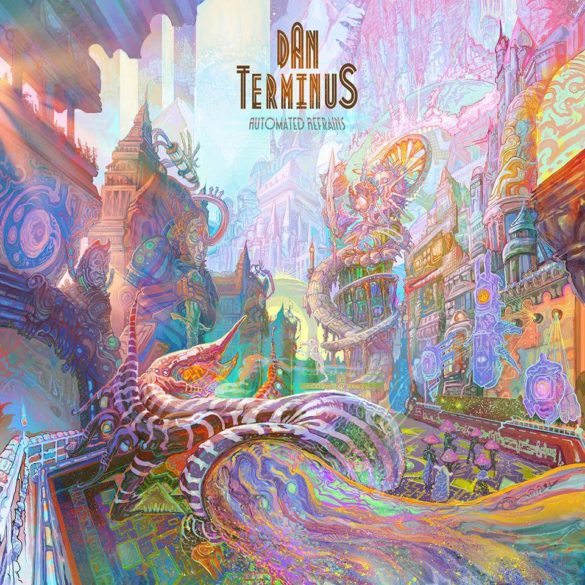
Were you thinking of continuing the Wrath of Code or going beyond it?
Dan Terminus: Absolutely not thinking of making the Wrath of Code 2. I was going for something else. The story of Code ends with the last track featuring Perturbator, and that’s it.
Who were some of your influences going into the record?
Dan Terminus: I’ll probably sound very artsy-fartsy by saying this but I was going through a rather dark and tough period of my life at the time, so I guess it influenced me a bit. I was also re-listening to my classics, stuff like Type O Negative, Jean-Michel Jarre, Tangerine Dream, the Misfits, Bathory, etc. I’m really turning into a grumpy guy these days. Friends and people send me new music everyday but it bores me. Nothing really slaps me in the face, which is a pity because I’m sure there is excellent music being released every day. I haven’t found that one band or that one artist who really makes me go “Wow!” I’m more of a Jeff Hanneman kind of guy, in that situation. I always get back to my own classics, just like a reader always gets back to his favorite books.
I’ve read where you’ve said “Grimoire Blanc” acts as the centerpiece to Automated Refrains. What did you mean by that?
Dan Terminus: It’s the track that contains the motto of the album, so to speak: pity for the perceived lifelessness which is in fact never truly lifeless. If there ever was a track to describe what it’s like to be a sentient machine, then it would be this one. It’s the less optimistic track on an album that’s totally not relying on a positive mood. Although “Grimoire Blanc” hits quite hard, it’s a reminder of ‘la condition humaine’ applied to machines, and the fact that we should always keep in mind that any sentient creation is just like us. “Grimoire Blanc” is trying to bring up some ideas, questions and thoughts about what it’s like to be a self-aware artificial creation in a world where the ‘makers,’ the ‘creators’ are long gone. Maybe I’m taking this too far, but it’s also like sending a sentient machine out there in space on the other end of the galaxy without intending to bring it back home, or using a sentient artificial being for rough sexual fantasies without caring for the machine’s thoughts and emotions. If the creators don’t feel compassion for their sentient creations, then who will? If the sentient creations are left to their own device in newly obtained freedom, then what happens next? That’s what “Grimoire Blanc” is about.
The record is all over the place thematically. It’s bright, it’s dark, it’s pensive, it’s direct. A song like “Angelus” and “Friendship through Clear Plastic Walls” are more thought-provoking compared to the heavy activity of “Margaritifer” and “Electronic Snow.”
Dan Terminus: “Electronic Snow” was supposed to contain samples from the video game Killer7, but I couldn’t clear the samples. A friend of mine vouched for me and contacted Grasshopper directly, who were very interested in the project but pointed us to Capcom because they didn’t own the rights to Killer7. I know for sure that the song ended up in Suda Goichi’s ears, and in Grasshopper’s workspace, and that they liked what they heard: so that’s enough to make me a happy man! The final version on the album contains my own synthesized speech samples, so as to avoid copyright infringements. And I have Suda Goichi’s blessing about it, so it’s cool!
The Luca Carey cover art is fantastic. Was the cover a completed piece or was it commissioned for Automated Refrains?
Dan Terminus: It was commissioned, as always with Luca. I gave him a few indications and let him do his thing. Luca is one talented painter, a true genius, whose art looks both familiar and surreal to me. So restraining him would have been a disaster. For other records, I’m even thinking of telling to paint whatever he pleases. I trust him one hundred percent. He spent 300 hours painting the cover (called The City of Forbidden Secrets) and almost lost his sanity in the process. Take a moment to zoom in on the amount of care, details and passion that he painstakingly poured into this piece. It makes my head swim. He also painted two more majestic pieces that are available with the digital version, and will also be featured in the digipack and vinyl version of the album.
What do you see in the cover?
Dan Terminus: Whatever you want to see. The beauty of such a painting is that anyone can see whatever they want. Helps maintaining the mystique of it all.
What’s next for Dan Terminus? Your fellow labelmates, like Perturbator and GosT, have started touring.
Dan Terminus: For now, it’s resting, spending time with family and friends, riding my motorcycle and not thinking about music. Then I’ll work on a better version of my live show, then we’ll see.
** Dan Terminus’ new album, Automated Refrains, is out now on Blood Music. Vinyl is available HERE. CD is available HERE. Order now or cry multi-color digital tears later.

